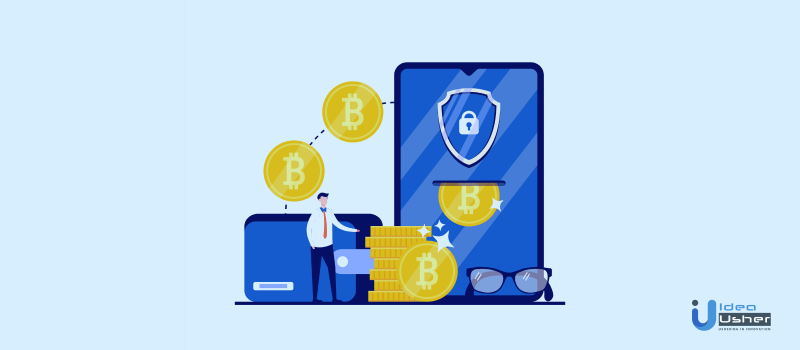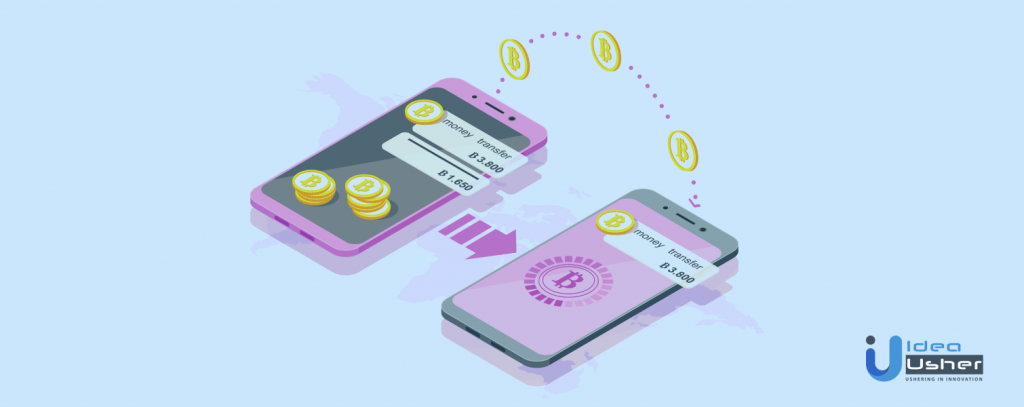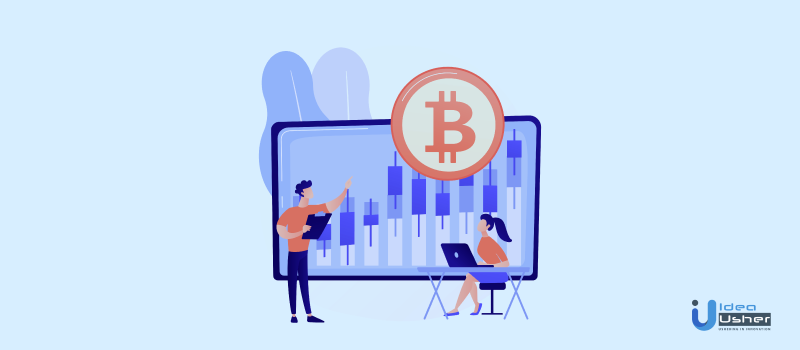Bitcoin is the new gold, and it is finite in supply. Do you know how many Bitcoins are there? Or do you know how many Bitcoins can there ever be? We are here to your rescue. With its blockchain-powered technology, it is changing the face of digital currency. In other words, it is set to change how we carry out transactions.
From investment to art or even paying for a drink in Japan, it is making a way everywhere. Want to be an active part of the revolution? Get a head start with Idea Usher’s bitcoin services.
How many bitcoins are there in circulation?
It is futile to put a pin on the exact number of Bitcoin in circulation. To stipulate, they are over 18 million and inching closer to the 19 million marks every 10 minutes.
Every 10 minutes, there’s a new addition of a block to the blockchain. It happens when a miner is successful in solving the puzzle (More on that ahead).
And, for each puzzle that a miner solves, he gets a reward of 6.25 in Bitcoin. This is how new Bitcoins enter circulation.
Since its genesis block in 2009, 89% of bitcoins have already been mined, and it’s only been over a decade. It might be surprising. Yet, one cannot ignore the hype around Bitcoin and its circulation.
Companies like Tesla are showing commitment to Bitcoin. With their undertaking investment, it grows more promising.

Bitcoin is Digital Gold or better?
It is a stark contrast to how Bitcoin met rejection and is now addressed as digital gold.
There are similarities between Gold and Bitcoin that are undeniable.
Some would say it’s better than digital gold. It is as precious as gold. Rather, one unit BTC is more precious and valuable than gold.
Extraction
The difference is that there is hard labor to extract the metal out of the earth to meet the demand. But, Bitcoin emerges out of thin air into the ledgers with computers. No wonder we call the process ‘mining’.
The computers have swapped shovels. Yet, you can work from anywhere—no need to go out looking for a site.
Decentralized
Governments and Institutions are responsible to regulate gold. Bitcoin has eliminated the need for authority. Unlike gold, there is no cost to store it, there is no manipulation in the supply chain, and it is not as likely to get stolen. With this mistrust and storing baggage, people prefer papers for gold. It is rather a burden to keep it with them. So, they put their trust with the banks to hold it with responsibility.
Bitcoins’ digital traits and their ability to take up no space elude these problems.
Haven from Inflation
Gold is always on the mantle space for its reputation. It has regards of a sanctuary in case of inflation in fiat currencies. Digital gold is doing that for holders too. Like gold, there’s a finite and regulated supply for Bitcoin. While the supply diminishes over time, the demand stays put.
Many critics would argue that with gold, one can mold it into jewelry and artifacts to use in real-time. The argument that gold is tangible can no longer hold solid ground.
Given that Bitcoin is a digital currency on its own, one can use it to pay for goods. Observing countries like Japan has more practical use than gold.
Who created Bitcoin?
Bitcoin has gathered much fame and criticism since it first emerged. It has sent quite a shockwave through industries. Taking a whole revolution by the horns, it has started the new wave of cryptocurrencies. Blockchain technology, and now NFTs are all a part of said wave.
With as much grandiose it associates with now, there’s as much mystery around its creator.
It came into this world as a digital currency in 2009. There was a white paper published under Satoshi Nakamoto. The creator’s identity was only a pseudonym. But, there are allegations that it could be a group of people if not a single mastermind.
The paper introduced Bitcoin as a peer-to-peer financial system to exchange digital currency. It meant to eliminate the need for traditional financial institutions. In the growing age of e-commerce and online banking and the whole world within our reach. It seems too much of our trust; we leave it with third-party institutions.
The idea was to drop blind trust as a factor. Instead, it serves as a channel available for everyone to cross-check. The transactions that took place through third parties were non-reversible. Institutions and authorities considered fraud, unavoidable. To seek a solution, it offers that funds stay in escrow before the network verifies the buyer and seller.
This idea didn’t take flight until 2011 when 1 BTC achieved a value of 1 dollar.
How many Bitcoin are there with Satoshi?
Satoshi believed in the vision of Bitcoin to change the world of financial exchange. However, not a lot of people were on board with him.
To keep the Bitcoin network afloat, he mined and minted coins alone. He would have help from another fanatic, Hal Finney.
From 2009 to 2011, Satoshi and few developers mined 5 million coins. It was the resting period for Bitcoin. A huge chunk of almost or over 23%. Many of these coins were lost. Nevertheless, there are speculations that Satoshi and initial miners still have those coins.
Even if Satoshi possesses 20% of that 5 million, he would still be a billionaire with the raging value of Bitcoin.
How does Bitcoin work?
A Bitcoin network is a collection of computer systems, often called the nodes. These nodes run the Bitcoins’ code and share it with the blockchain.
Blockchain is a collection of blocks that store transaction information with timestamps. All these blocks chained together form the blockchain. It has all information from the original to the present blocks and transactions.
With all its embedded information in the blocks, it is transparent and available
This blockchain technology network is efficient, foolproof with a ‘no-one-can-cheat’ trait.
To override the current blockchain, 51% of the total operating power of the whole network is a must. As of early 2021, there are 12000 active nodes.

These are the components of the Bitcoin network :
Balances – The Public Ledger
All the nodes form a shared public ledger. This ledger quantifies how many bitcoins are there. It also calculates the spendable bitcoin balances in wallets. This ensures that the amount required to spend is available in the wallet. Otherwise, the transaction does not goes through.
Users – Peer-to-peer
In these regards, Bitcoin was one of its kind at the time of its origin. With decentralization, users can carry out an exchange without any third-party channel. The transactions’ approval depends on the miner solving the puzzle.
Processing – Miners
Miners are a vital part of verifying the transactions. To add the block, the miners solve the puzzle with the computing power at their disposal. The network rewards the successful miner with Bitcoin and adds the block to the chain (more on this ahead).
Who controls Bitcoin?
As discussed, Satoshi Nakamoto is the creator of Bitcoin. It was registered under two developers; Satoshi, himself, and Martti Malmi.
But, Satoshi moved onto other things, leaving the project. He didn’t want anyone to establish a monopoly. To remedy that he passed on the ownership to more developers. These developers further spread the responsibility.
Bitcoin, as Satoshi intended, belongs to all users worldwide. It is a decentralized peer-to-peer channel in all terms.
As bitcoin.org suggests, the developers alone cannot make a dent in the network. All the users have to comply and choose to work with it.
There is much criticism and debate about the control of the Bitcoin network. Many argue that leading investors control the network like other markets.
For the most part, the Bitcoin network is like other markets. It, too, has an ecosystem that operates on ‘Laisse affaire.’ Yet, it provides more security and protection unlike traditional banking and financial institutions.
Bitcoin Mining
Bitcoin mining is the building block for the blockchain, quite literally. The technology can neither live nor thrive without mining. Therefore, mining is vital to maintaining and developing the blockchain.
- New Bitcoins in circulation
This process introduces new bitcoins to circulation. It requires a sophisticated computational ability with the speed of lightning. Or if not lighting, at least at a fast enough competitive speed.
- A math puzzle
Bitcoin mining is a competition to solve the math puzzle before any other computers that are at it. This, in turn, earns the miner Bitcoin in reward without having to invest any capital.
- Verifies Transaction
Mining is much like auditing transactions, like any banking or financial institution. Bitcoin exists on a decentralized, open ledger that runs across a global network. It requires verification for all the transactions. Mining is essential to the verification and a vital part of the network.
Digital assets are radically copied, replicated, and reproduced. Bitcoin is a digital currency that is more susceptible to something like that.
For instance,
A Bitcoin owner can duplicate the token,
pass on the fake version for a transaction,
And save the original one untapped.
This can be a vicious loop.
To keep the users honest and legit, the creator Satoshi instilled a reward for miners. Anonymous verifiers auditing the transactions protect against ‘double-spending.
How to mine Bitcoins?
We have an understanding of how and why mining is like a soul to Bitcoin. We know that it is rewarding.
Let’s dive deeper into the process to carry it out.
- The mining in all regards is a competitive race that takes place every ten to twelve minutes. The blockchain only wants to produce a new block in the mentioned window. This makes the competition cut-throat, fierce and scarce.
- Despite the fierce competition, the math puzzles involved are mere guesswork. The miners are competing to find the 64-digit hexadecimal number (hash). They have to fetch it out of four billion nonce -hash combinations to find the right one
- The miners are racing to solve these puzzles to earn the shiny bitcoin. To succeed, a miner computes thousands of calculations a second to find the right one. Since it’s a decentralized system, anyone can join in on the network and begin solving puzzles. But, it’s not that easy.
- As more miners hop in on the mining wagon, the likeliness of solving a puzzle fast soars. The Bitcoin network evolves and accommodates this by making the puzzle harder. To adapt to a higher level of difficulty, it changes the numerical value part of the puzzle.
- To win the race and solve these many puzzles, a miner needs a high hash rate. Hash rate determines how many combinations are sort in a second. The higher the hash rate, the more chances to land the puzzle piece.
Consequently, a miner needs higher computing power to meet a significant hash rate. Higher computing power requires powerful computers, pieces of equipment, and intense amounts of electricity.
Bringing all this must need investment. And that fact that its guesswork, there’s only one winner every ten-twelve minutes.
How many Bitcoins are there to mine?
We have already answered how many bitcoins are there and there are over 18 million-plus to count. But, the supply of bitcoin is finite with 21 million written in its code.
With easy math, we know that there are close to 3 million bitcoins still available to mine.
The first decade of its creation minted 18 million Bitcoins. Following this, it might seem that we are in the final stages of mining. Only about time that the supply exhausts.
Yet, the Bitcoin Network says, ‘not so soon.
Most of the bitcoins have indeed been mined; its code runs deeper and more complex than that.
We have established that each successful addition of a block rewards the miners. The process transforms over time, and that reward gets halved.
When bitcoin was first launched, the reward for the miner was a solid 50 Bitcoins. However, most people didn’t engage, and most of those coins were lost (more on that later).
Bitcoins follow a pattern of halving the reward every four years. To elaborate,
2009 – Reward is 50 (genesis),
2012 – Reward is 25,
2016 – Reward is 12.5
Mining reward reduced to 6.25 in 2020. As of February 2021, a miner would hold close to $300,000 in reward due to the coin’s value. This is clear that Satoshi kept the inflation rate in mind while programming. After all, it is effective and taking charge.
While it seems there are 3 million bitcoins to mine, it will take a while to defeat that number. It will take almost a century before mining the last Bitcoin, and we could delve into its aftermath.
How many Bitcoins are mined each day?
Though it was a struggle for Bitcoin to survive, now it’s thriving. More tech-savvy crypto enthusiasts and blockchain fanatics join the ever-increasing army of miners. These numbers are not speculated to go down.
The Bitcoin network is a decentralized open ledger. Parallel to its reputation, it cannot keep out the miners, so it evolves itself.
Blockchain offers a chance to mine a block, only every 10 minutes. Therefore, the limited number of blocks becomes a part of the chain.
Let’s see how :
The network only allows one block to be added every 10 minutes.
The reward for each block is 6.25 as of 2020 when it last halved.
Thus, with 1440 minutes in a day,
A number of 144 blocks can be added daily.
And blocks combine with reward; there are 144 X 6.25 = 900 Bitcoins.
With that, only 900 bitcoins emerge every day.
However, buytbitcoinwordwide.com reports that a solid increment in miner’s hash power reduces the time from 10 to 9.5 minutes. This allows more than 900 bitcoins to be added every day.
What happens when all Bitcoins are mined?
There is indeed a finite supply of Bitcoin. And with passing years, the unit of Bitcoin rewarded to miners decreases by half every four years. It is, by all means, correct to state that Bitcoin will exhaust in the future.
It goes on without saying that with decreasing units, the rewards will be diminishing. But, there will always be a transaction fee involved with every exchange. While it is at a few bucks per block, this fee could rise to a significant sum in the future. Bitcoin is like crypto gold, and the liquidity is much likely to increase and soar.
There will be miners who will keep at it. To say how profitable it will exactly be for miners will depend on simple profit and loss equations.
It will take into account the cost of energy and computing power that goes into mining.
Speculating consumption charges 100 years from now is an uncertain task.
It could be that mining, from a business idea, could just resolve into a hobby for extra time. Or energy sources could grow efficiently and transaction fees can get profitable.
It is also likely that the Bitcoin network could go under changes and evolves. This could lead to the expansion of the network to accommodate more currency.
When will the last Bitcoin be mined?

It seems like simple math to speculate Bitcoin’s value and demand, it always surprises us. With an initial lash against the idea, no one could have expected Bitcoin to be the digital gold of the era.
However, Bitcoin has stayed true to its coding and network. It has been following a steady pattern and evolving with each additional block.
We have calculated how many bitcoins are mined each day. We know how many Bitcoins there are. With this, it seems like a simple ticking clock till the last Bitcoin is mined.
To know when they will last Bitcoin be mined, we take into account:
The halving rate of the reward for mining
The Bitcoin reward for the miner halves every four years. A miner currently gets 6.25 units for verifying the puzzle.
The addition of a new block at a 10-minute interval
With increasing miners, the network evolves and makes the puzzles harder to solve. This maintains the 10-minute interval and keeps the circulation steady.
The steady demand and the lowering supply
Lowering the mining reward regulates the minting of new coins. Given that the demand stays put and the supply decreases, the value of the coin increases.
Even taking notice of these factors, it could still take over 100 years before the last Bitcoin. However, Investopedia ascertains that it won’t be until 2140 that all Bitcoins will be mined.
Why is the halving of the Bitcoin reward significant?
Having is an event on the blockchain timeline where the reward for the miners reduces by half.
There is a norm that it happens every four years, which is correct on the surface. However, it depends on the height of the block. Once the chain reaches the mark of 210,000 blocks, to be precise.
The consistent reward would have already exhausted the Bitcoin ecosystem at that rate.
Bitcoin, since its origin, has evolved and changed, adapting to the increasing demand. With its golden statue, Bitcoin is not a currency; it’s part of a culture. And that culture celebrates decentralization and direct interactions between the users. In addition, it provides a ground for investors and fanatics who are in for the challenge and fun.
Satoshi had such faith in his creation that he expected it to become a part of an ecosystem like this.
Halving allows controlling the inflation rate. It keeps it from becoming a monopoly under one major sect. Thus, it will keep Bitcoin from becoming a closed economy too soon.
The halving of Bitcoin is a celebration worldwide. Major cities like Melbourne, Paris, NYC, and more host parties for the event. These cities express a major interest in cryptocurrency and blockchain technology.
There is the clock ticking until the next halving of the reward. After this, the reward will reduce to 3.125 Bitcoin for every block for the fourth time. This will mark the addition of 840,000 blocks to the blockchain.
How many Bitcoins are there: Other Considerations
How many Bitcoins are lost? What does it mean?
Unchained Capital compares the loss of bitcoins to the carboniferous era. It was when trees, so fiercely, overpopulated the earth. There was no life to feed on them and stimulate their growth in balance. The trees fell on the ground and would not decay properly, hurting the ecology.
The story of the Bitcoin loss is closely related. Initially, when Santoshi created Bitcoin, there was hardly anyone to mine or get excited about the venture.
In 2009, Santoshi was mining along, sometime Hal Finney would come to play. Due to a lack of hash rate, the mining could not hit the target of producing a block at a 10-minute interval.
Despite the slow rate, as the mining reward was higher, Santoshi and a few other miners minted over 5 million Bitcoin. This happened from 2009 to 2011.
It was in 2011 April that 1BTC touched the $1 mark.
Bitcoin uses the UTXO (Unspent Transaction Output) system of accounting. This means that all the transactions (blocks) have timestamps and indicates creation.
Moreover, the bitcoins also have an age to show when they were in use in a transaction the last time. The blockchain stores all the information explicitly. This is why it is possible to trace it back and now the existence of a coin and its block.
Who has the most cryptocurrency: the millionaires of crypto

Despite the launch of various cryptocurrencies, Bitcoin holds the mantle.
There are speculations that Satoshi (Bitcoin’s creator) holds the largest number of Bitcoins. This would make him one of the 40 richest people in the world. Yet, it is only a claim.
However, here is a list of the crypto giants:
- Barry Silbert – Chief Executive Officer and founder of Digital Currency Group
- Blythe Masters – CEO of Digital Assets Holdings. Former Managing Director of JP Morgan Chase & Co
- Dan Morehead – Founder of Pantera Capital, the first company based on cryptocurrencies investments
- Tyler and Cameron Winklevoss – Founders of Gemini, world’s first exchange for crypto
- Michael Novogratz – A billionaire to invest 30% of his fortune into cryptocurrencies
Conclusion

Bitcoin is a raging revolution, not just for technology but for culture as well. 89% of Bitcoins have already been mined, but there is a whole century before us before its exhaustion. Its integration into the mainstream ecosystem has been a roller coaster ride. It is not only for the tech-savvy but people from all walks of life are participating in it. It is giving rise to a new culture and a whole new way to invest. The exploration of how many bitcoins there are and how they are doing here is sure to stir interest to be a part of it. Idea Usher offers a wide variety of blockchain services and can give you the front row seat.





















